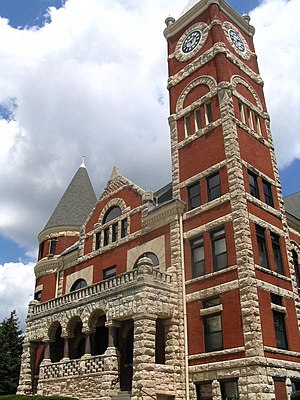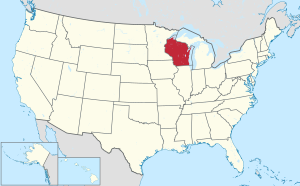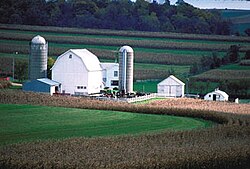County in Wisconsin
| Green County | |
|---|---|
| County | |
 Green County Courthouse Green County Courthouse | |
 Location within the U.S. state of Wisconsin Location within the U.S. state of Wisconsin | |
 Wisconsin's location within the U.S. Wisconsin's location within the U.S. | |
| Coordinates: 42°41′N 89°36′W / 42.68°N 89.6°W / 42.68; -89.6 | |
| Country | |
| State | |
| Founded | 1837 |
| Named for | Nathanael Greene |
| Seat | Monroe |
| Largest city | Monroe |
| Area | |
| • Total | 584 sq mi (1,510 km) |
| • Land | 584 sq mi (1,510 km) |
| • Water | 0.5 sq mi (1 km) 0.09% |
| Population | |
| • Total | 37,093 |
| • Estimate | 36,951 |
| • Density | 63.5/sq mi (24.5/km) |
| Time zone | UTC−6 (Central) |
| • Summer (DST) | UTC−5 (CDT) |
| Congressional district | 2nd |
| Website | www |
Green County is a county located in the U.S. state of Wisconsin. As of the 2020 census, the population was 37,093. Its county seat is Monroe. Green County is included in the Madison, WI Metropolitan Statistical Area.
History
The land of Green County had long been settled by Native Americans. In 1632, Samuel de Champlain included this area in the region belonging to the Illinois, and in the 18th century the Sauk mined lead within the present county limits. By the time the first white settlers arrived there, all of Green County was the property of the Ho-Chunk, who referred to the mines as the "Sac Diggings." The federal government recognized Indian title to frontier land, and generally forbade the private sale of Indian land to individuals, but as squatters continued to work the mines in southwestern Wisconsin, conflict arose between them and the Ho-Chunk, as well as the Sauk and Meskwaki, all of whom mined and sold lead. In 1832, Black Hawk attempted to bring his people back into their former Illinois lands, they were pursued across the border into Wisconsin, then known as western Michigan Territory. The Ho-Chunk were divided in the Black Hawk War, with many warriors siding with the Sauk, and others taking personal revenge on frontier settlers in the lead mining district. Although many other Ho-Chunk aided the US army in pursuing the Sauk, they were coerced into selling their lands south of the Wisconsin River in a treaty signed in September, one month after Black Hawk's surrender. Although other towns had been founded in the lead region of Wisconsin prior to the land cession, Monroe, Wisconsin was one of the many communities founded in the mid-1830s after this land became legally open to settlement.
The county was created in 1837 from the Wisconsin Territory. When in December 1837, a new county was to be split off from the over-large Iowa County, William Boyles of Monroe, as the Representative of the area, was allowed to choose a name. He chose Green County, after the verdant color of the vegetation there. Another member suggested that it be modified to "Greene" after General Nathanael Greene, who commanded the Southern Campaign in the American Revolutionary War but Boyles insisted on his original choice. The story that it was named for General Greene still persists in some circles.
Geography
According to the U.S. Census Bureau, the county has a total area of 584 square miles (1,510 km), of which 584 square miles (1,510 km) is land and 0.5 square miles (1.3 km) (0.09%) is water.
Major highways
 Highway 11 (Wisconsin)
Highway 11 (Wisconsin) Highway 39 (Wisconsin)
Highway 39 (Wisconsin) Highway 59 (Wisconsin)
Highway 59 (Wisconsin) Highway 69 (Wisconsin)
Highway 69 (Wisconsin) Highway 78 (Wisconsin)
Highway 78 (Wisconsin) Highway 81 (Wisconsin)
Highway 81 (Wisconsin) Highway 92 (Wisconsin)
Highway 92 (Wisconsin) Highway 104 (Wisconsin)
Highway 104 (Wisconsin)
Railroads
Buses
Airport
Monroe Municipal Airport (KEFT) serves the county and surrounding communities.
Adjacent counties
- Dane County - north
- Rock County - east
- Winnebago County, Illinois - southeast
- Stephenson County, Illinois - south
- Lafayette County - west
- Iowa County - northwest
Demographics
| Census | Pop. | Note | %± |
|---|---|---|---|
| 1840 | 933 | — | |
| 1850 | 8,566 | 818.1% | |
| 1860 | 19,808 | 131.2% | |
| 1870 | 23,611 | 19.2% | |
| 1880 | 21,729 | −8.0% | |
| 1890 | 22,732 | 4.6% | |
| 1900 | 22,719 | −0.1% | |
| 1910 | 21,641 | −4.7% | |
| 1920 | 21,568 | −0.3% | |
| 1930 | 21,870 | 1.4% | |
| 1940 | 23,146 | 5.8% | |
| 1950 | 24,172 | 4.4% | |
| 1960 | 25,851 | 6.9% | |
| 1970 | 26,714 | 3.3% | |
| 1980 | 30,012 | 12.3% | |
| 1990 | 30,339 | 1.1% | |
| 2000 | 33,647 | 10.9% | |
| 2010 | 36,842 | 9.5% | |
| 2020 | 37,093 | 0.7% | |
| U.S. Decennial Census 1790–1960 1900–1990 1990–2000 2010 2020 | |||
2020 census
As of the census of 2020, the population was 37,093. The population density was 63.5 people per square mile (24.5 people/km). There were 16,273 housing units at an average density of 27.9 units per square mile (10.8 units/km). The racial makeup of the county was 92.5% White, 0.6% Black or African American, 0.5% Asian, 0.3% Native American, 1.9% from other races, and 4.3% from two or more races. Ethnically, the population was 4.0% Hispanic or Latino of any race.
2000 census

As of the 2000 census, there were 33,647 people, 13,212 households, and 9,208 families residing in the county. The population density was 58 people per square mile (22 people/km). There were 13,878 housing units at an average density of 24 units per square mile (9.3 units/km). The racial makeup of the county was 98.14% White, 0.26% Black or African American, 0.21% Native American, 0.29% Asian, 0.36% from other races, and 0.75% from two or more races. 0.97% of the population were Hispanic or Latino of any race. 31.9% were of German, 20.3% Swiss, 14.9% Norwegian, 6.7% Irish, 5.7% English and 5.5% American ancestry. 96.5% spoke English, 2.0% German and 1.1% Spanish as their first language.
There were 13,212 households, out of which 33.70% had children under the age of 18 living with them, 58.30% were married couples living together, 7.50% had a female householder with no husband present, and 30.30% were non-families. 25.00% of all households were made up of individuals, and 11.20% had someone living alone who was 65 years of age or older. The average household size was 2.51 and the average family size was 3.01.
In the county, the population was spread out, with 26.50% under the age of 18, 6.70% from 18 to 24, 29.20% from 25 to 44, 22.90% from 45 to 64, and 14.70% who were 65 years of age or older. The median age was 38 years. For every 100 females there were 96.90 males. For every 100 females age 18 and over, there were 94.20 males.
As late as the 1970 federal census, Green County was the only county in the United States in which the largest foreign-born population was people born in Switzerland.
Communities

Cities
- Brodhead (partly in Rock County)
- Monroe (county seat)
Villages
- Albany
- Belleville (mostly in Dane County)
- Brooklyn (mostly in Dane County)
- Browntown
- Monticello
- New Glarus
Towns
- Adams
- Albany
- Brooklyn
- Cadiz
- Clarno
- Decatur
- Exeter
- Jefferson
- Jordan
- Monroe
- Mount Pleasant
- New Glarus
- Spring Grove
- Sylvester
- Washington
- York
Census-designated place
Unincorporated communities
- Attica
- Clarno
- Dayton
- Exeter
- Jordan Center
- Martintown
- Mineral Point
- Postville
- Oakley
- Ross Crossing
- Schneyville
- Schultz
- Stearns
- Twin Grove
Ghost towns/neighborhoods
Politics
| Year | Republican | Democratic | Third party(ies) | |||
|---|---|---|---|---|---|---|
| No. | % | No. | % | No. | % | |
| 2024 | 10,843 | 49.12% | 10,903 | 49.39% | 330 | 1.49% |
| 2020 | 10,169 | 47.51% | 10,851 | 50.69% | 386 | 1.80% |
| 2016 | 8,693 | 45.79% | 9,122 | 48.05% | 1,170 | 6.16% |
| 2012 | 7,857 | 40.66% | 11,206 | 58.00% | 259 | 1.34% |
| 2008 | 6,730 | 36.31% | 11,502 | 62.06% | 302 | 1.63% |
| 2004 | 8,497 | 46.56% | 9,575 | 52.47% | 176 | 0.96% |
| 2000 | 6,790 | 44.45% | 7,863 | 51.47% | 623 | 4.08% |
| 1996 | 4,697 | 37.23% | 6,136 | 48.64% | 1,783 | 14.13% |
| 1992 | 4,887 | 34.46% | 5,467 | 38.55% | 3,829 | 27.00% |
| 1988 | 6,636 | 55.73% | 5,153 | 43.27% | 119 | 1.00% |
| 1984 | 7,827 | 63.65% | 4,367 | 35.52% | 102 | 0.83% |
| 1980 | 7,714 | 54.03% | 5,336 | 37.37% | 1,227 | 8.59% |
| 1976 | 7,085 | 54.31% | 5,632 | 43.17% | 329 | 2.52% |
| 1972 | 7,422 | 66.14% | 3,634 | 32.38% | 166 | 1.48% |
| 1968 | 6,502 | 61.03% | 3,501 | 32.86% | 651 | 6.11% |
| 1964 | 5,364 | 49.08% | 5,548 | 50.76% | 17 | 0.16% |
| 1960 | 7,939 | 67.79% | 3,766 | 32.16% | 6 | 0.05% |
| 1956 | 7,114 | 66.00% | 3,614 | 33.53% | 51 | 0.47% |
| 1952 | 7,949 | 70.46% | 3,326 | 29.48% | 6 | 0.05% |
| 1948 | 4,403 | 52.43% | 3,881 | 46.21% | 114 | 1.36% |
| 1944 | 5,556 | 57.28% | 4,101 | 42.28% | 42 | 0.43% |
| 1940 | 5,711 | 55.10% | 4,565 | 44.05% | 88 | 0.85% |
| 1936 | 3,700 | 37.53% | 5,941 | 60.26% | 218 | 2.21% |
| 1932 | 3,190 | 36.42% | 5,406 | 61.73% | 162 | 1.85% |
| 1928 | 5,152 | 64.18% | 2,812 | 35.03% | 63 | 0.78% |
| 1924 | 2,922 | 35.07% | 423 | 5.08% | 4,986 | 59.85% |
| 1920 | 5,466 | 84.68% | 633 | 9.81% | 356 | 5.52% |
| 1916 | 2,422 | 55.77% | 1,687 | 38.84% | 234 | 5.39% |
| 1912 | 1,601 | 38.82% | 1,716 | 41.61% | 807 | 19.57% |
| 1908 | 2,617 | 54.48% | 1,856 | 38.63% | 331 | 6.89% |
| 1904 | 2,992 | 62.05% | 1,466 | 30.40% | 364 | 7.55% |
| 1900 | 2,996 | 60.21% | 1,776 | 35.69% | 204 | 4.10% |
| 1896 | 3,093 | 54.72% | 2,339 | 41.38% | 220 | 3.89% |
| 1892 | 2,329 | 46.05% | 2,052 | 40.57% | 677 | 13.38% |
Until the 1992 presidential election, Green County voters primarily backed the Republican Party candidate in national elections. Prior to that year, the only times they failed to win the county were in the midst of a divided party vote in 1912, the presence of Wisconsinite Robert La Follette on the ballot in 1924, and national Democratic Party landslides in 1932, 1936, & 1964. From 1992 onward, the county has backed the Democratic candidate in every presidential election, though their margins of victory have been often relatively narrow.
See also
References
- ^ "2020 Decennial Census: Green County, Wisconsin". data.census.gov. U.S. Census Bureau. Retrieved July 8, 2022.
- "Find a County". National Association of Counties. Archived from the original on May 31, 2011. Retrieved June 7, 2011.
- "A Brief History of Monroe". Wisconsin Historical Society. Wisconsin State Historical Society. July 27, 2012. Retrieved November 8, 2023.
- "History of Green County, Wisconsin. together with biographies of representative citizens. history of Wisconsin, embracing accounts of the pre-historic races, and a brief account of its territorial and state governments. - Full view - UWDC - UW-Madison Libraries". search.library.wisc.edu. Union Publishing Company. Retrieved November 8, 2023.
- Marty, Dwayne L. "Old Exeter And The Sugar River Diggings" (PDF). Monticello Historical Society. Monticello Historical Society. Retrieved November 8, 2023.
- "Wisconsin: Individual County Chronologies". Wisconsin Atlas of Historical County Boundaries. The Newberry Library. 2007. Archived from the original on April 14, 2017. Retrieved August 13, 2015.
- History of Green County, Wisconsin. together with biographies of representative citizens. history of Wisconsin, embracing accounts of the pre-historic races, and a brief account of its territorial and state governments Springfield, Illinois: Union Pub. Co., 1884; p. 220
- Gannett, Henry (1905). The Origin of Certain Place Names in the United States. Govt. Print. Off. p. 143.
- "2010 Census Gazetteer Files". United States Census Bureau. August 22, 2012. Retrieved August 4, 2015.
- "U.S. Decennial Census". United States Census Bureau. Retrieved August 4, 2015.
- "Historical Census Browser". University of Virginia Library. Retrieved August 4, 2015.
- Forstall, Richard L., ed. (March 27, 1995). "Population of Counties by Decennial Census: 1900 to 1990". United States Census Bureau. Retrieved August 4, 2015.
- "Census 2000 PHC-T-4. Ranking Tables for Counties: 1990 and 2000" (PDF). United States Census Bureau. April 2, 2001. Archived (PDF) from the original on October 9, 2022. Retrieved August 4, 2015.
- "State & County QuickFacts". United States Census Bureau. Archived from the original on June 6, 2011. Retrieved January 18, 2014.
- "U.S. Census website". United States Census Bureau. Retrieved May 14, 2011.
- Leip, David. "Dave Leip's Atlas of U.S. Presidential Elections". uselectionatlas.org. Retrieved November 11, 2020.
Further reading
- Commemorative Biographical Record of the Counties of Rock, Green, Grant, Iowa, and Lafayette, Wisconsin, Containing Biographical Sketches of Prominent and Representative Citizens, and of Many of the Early Settled Families. Chicago: J. H. Beers and Co., 1901.
- History of Green County, Wisconsin. Springfield, Ill.: Union Publishing Company, 1884.
External links
- Green County government website Archived January 3, 2018, at the Wayback Machine
- Green County map from the Wisconsin Department of Transportation
- Green County Sheriff's Office
| Places adjacent to Green County, Wisconsin | ||||||||||||||||
|---|---|---|---|---|---|---|---|---|---|---|---|---|---|---|---|---|
| ||||||||||||||||
| Municipalities and communities of Green County, Wisconsin, United States | ||
|---|---|---|
| County seat: Monroe | ||
| Cities |  | |
| Villages | ||
| Towns | ||
| CDP | ||
| Other communities | ||
| Ghost towns | ||
| Footnotes | ‡This populated place also has portions in an adjacent county or counties | |
42°41′N 89°36′W / 42.68°N 89.60°W / 42.68; -89.60
Categories: